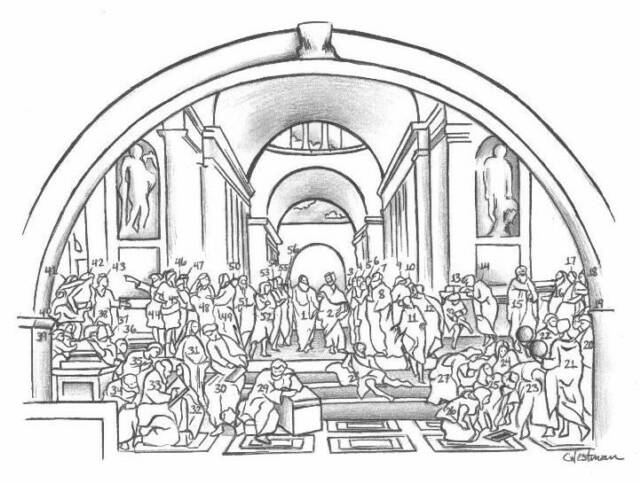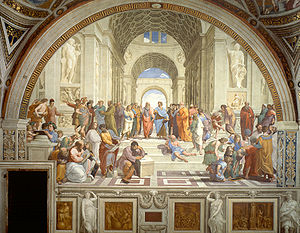1) Plato holding the Timaeus and pointing to the heavens symbolizing the Idealism that characterizes his view of the world (the face is that of Leonardo Da Vince, who was Raphael's
Plato holding the Timaeus and pointing to the heavens symbolizing the Idealism that characterizes his view of the world (the face is that of Leonardo Da Vince, who was Raphael's 

 mentor)
mentor)
2) Aristotle holding the Ethics and gesturing towards the earth symbolizing the Realism that characterizes his view of the
Aristotle holding the Ethics and gesturing towards the earth symbolizing the Realism that characterizes his view of the  world
world
3) Unknown
Unknown
4) Unknown
Unknown
5) Unknown
Unknown
6) Unknown
Unknown
7) Unknown
Unknown
8) Theopratus of Lesbos
Theopratus of Lesbos
9) Unknown
Unknown
10) Unknown
Unknown
11) Unknown
Unknown
12) Aristippus
Aristippus
13) Unknown
Unknown
14) Pyrrho of Elis
Pyrrho of Elis
15) Plotinus, 3rd Century Neo-Platonist
16) Unknown
Unknown
17) Unknown
Unknown
18) Unknown
19) Raphael - the artist
20) Perugino - Raphael’s teacher.
Perugino - Raphael’s teacher.
21) Ptolemy holds an earthly globe
Ptolemy holds an earthly globe
22) Zoroaster holds a globe of the starry universe.
Zoroaster holds a globe of the starry universe.
23) Euclid - painted with s the features of Raphael’s great mentor
Euclid - painted with s the features of Raphael’s great mentor
Donato Bramante who, as architect of St. Peter’s.
24) 1st student anticipates the outcome of his teacher’
1st student anticipates the outcome of his teacher’
demonstration
25) 2nd student shows the excitement of dawning
2nd student shows the excitement of dawning
 comprehension
comprehension
26) 3rd student is at the phase of comprehension
3rd student is at the phase of comprehension
27) His encouraging pat suggests that this may be an apprentice
His encouraging pat suggests that this may be an apprentice
teacher
These figures are all focused upon a slate with a diagram, drawing attention to the faculty of sight, which is also used by the astronomers who hold globes in their hands
28) Diogenes the Cynic is reading with a beggar’s cup in front.
Diogenes the Cynic is reading with a beggar’s cup in front.
29) Heraclitus is a glum and antisocial character with the face of
Michelangelo.
30) Hypatia or Francesco Marie della Rovero
31) Parmenides or the musician Nicomachus
Parmenides or the musician Nicomachus
32) Anaxagoras
Anaxagoras
33) Pythagoras
Pythagoras
34) Empedocles
Empedocles
35) Epicharmus or Averroes
Epicharmus or Averroes
36) Federico II of Mantua
Federico II of Mantua
37) Epicurus - founder of Hedonist Schoof of Philosophy
Epicurus - founder of Hedonist Schoof of Philosophy
38) Unknown
Unknown
39) Unknown
Unknown
40) Zeno of Critum - founder of the Stoic School of Philosophy
Zeno of Critum - founder of the Stoic School of Philosophy
41) Gorgias of Leontini
Gorgias of Leontini
42) Diagoras of Melos
Diagoras of Melos
43) Kritias of Athens
Kritias of Athens
44) Aechines
Aechines
45) Alcibiades is attired in armor embellished in gold
Alcibiades is attired in armor embellished in gold
46) Xenophon
Xenophon
47) Unknown
Unknown
48) Alexander
Alexander
49) Socrates
Socrates
The sculpture at upper left is Apollo, god of poetry, music, and health. He has a lyre in one hand and the other rests upon a trunk around which coils the serpent (the Greek symbol of health). This god of beauty and harmony stands above two reliefs depicting the unmoderated passions of wrath and concupiscence.
The Sculpture above Plotinus is Athena, goddess of wisdom, crafts, and war. She is dressed in military garb and on her shield is the terrifying face of the Gorgon. Below her is a relief of Virtue elevated upon clouds, holding one hand at her breast, the seat of valor, while extending the other toward the earth with the scepter of her empire.





